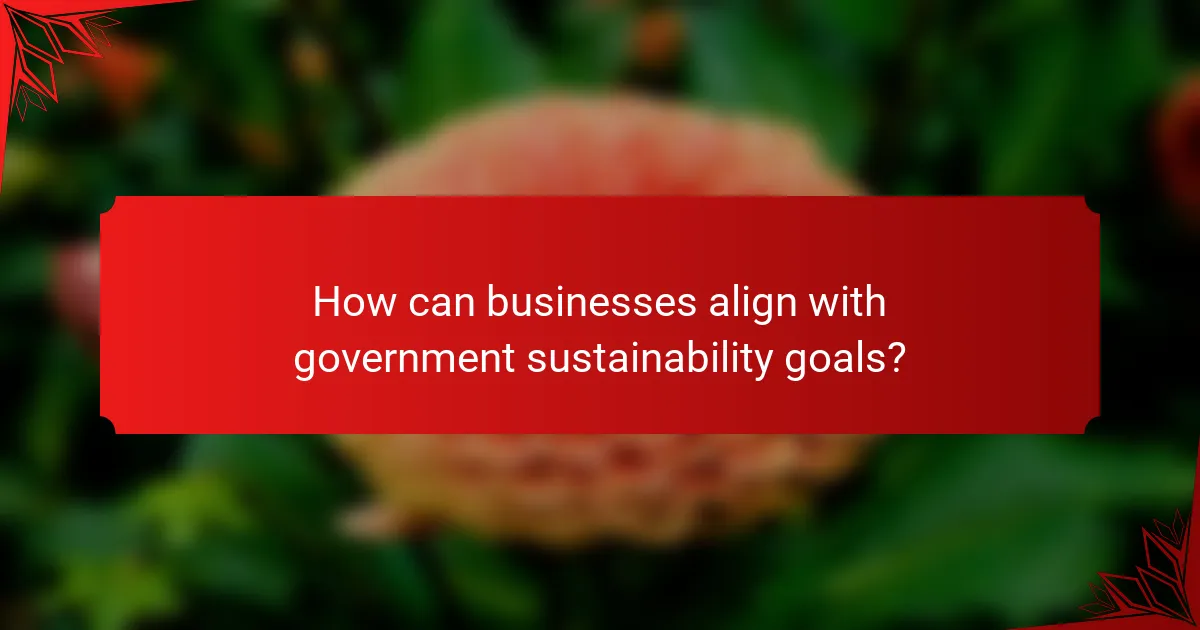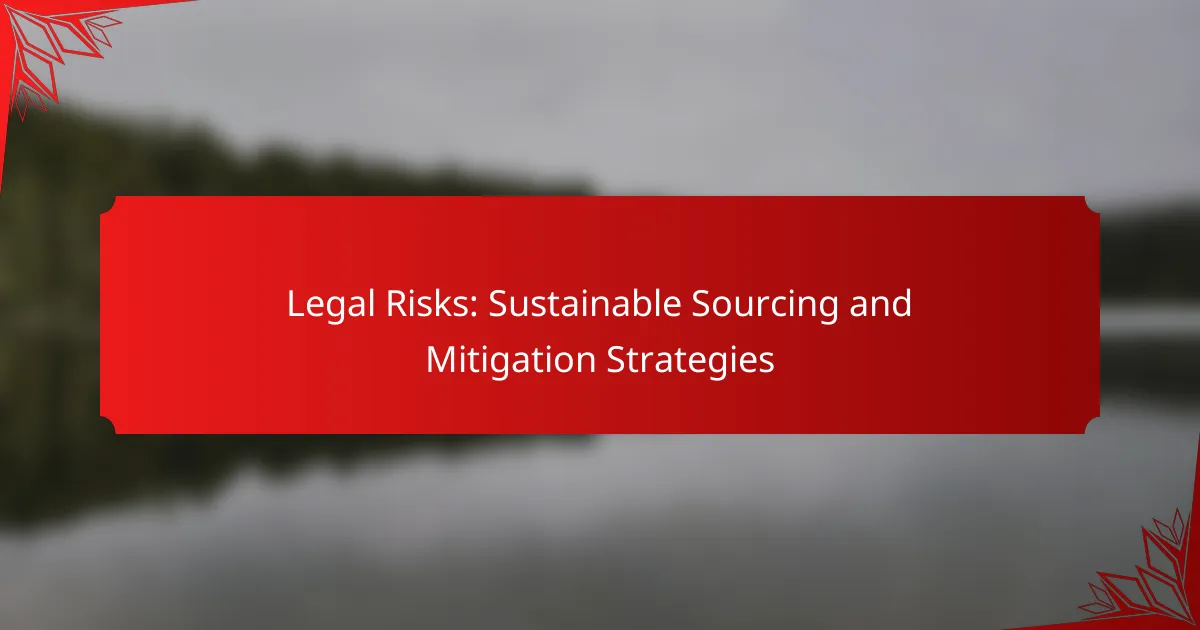Government policies are essential in fostering sustainability by setting regulations, offering incentives, and promoting eco-friendly practices across different sectors. These initiatives not only aim to mitigate environmental harm but also encourage economic development and innovation. Compliance with sustainability regulations is crucial for businesses, as it helps ensure transparency and accountability in their operations while contributing to a healthier planet.

How do government policies promote sustainability in the United States?
Government policies in the United States play a crucial role in promoting sustainability by establishing regulations, providing incentives, and supporting sustainable practices across various sectors. These policies aim to reduce environmental impact while encouraging economic growth and innovation.
Regulatory frameworks
Regulatory frameworks set the legal standards that businesses and individuals must follow to ensure sustainable practices. Key regulations include the Clean Air Act and the Clean Water Act, which limit emissions and protect water resources, respectively. Compliance with these regulations often requires companies to adopt cleaner technologies and practices.
Additionally, states may implement their own regulations that align with federal standards but can be more stringent. For example, California has established ambitious greenhouse gas reduction targets, influencing other states to adopt similar measures.
Incentives for renewable energy
Government incentives for renewable energy aim to make clean energy sources more accessible and affordable. These incentives can include tax credits, grants, and rebates for solar panels, wind turbines, and other renewable technologies. The federal Investment Tax Credit (ITC) allows homeowners and businesses to deduct a significant percentage of the cost of installing solar energy systems from their federal taxes.
States often offer additional incentives, such as net metering policies that allow consumers to sell excess energy back to the grid, further promoting the adoption of renewable energy. These financial benefits can significantly reduce the upfront costs associated with transitioning to sustainable energy sources.
Support for sustainable agriculture
Support for sustainable agriculture includes policies that promote environmentally friendly farming practices, such as crop rotation, organic farming, and reduced pesticide use. The USDA offers programs that provide financial assistance and technical support to farmers who implement sustainable practices, helping them to improve soil health and reduce chemical runoff.
Additionally, government initiatives like the Conservation Reserve Program (CRP) incentivize landowners to convert environmentally sensitive land into conservation areas, enhancing biodiversity and protecting natural resources. These programs not only support farmers but also contribute to the overall sustainability of the agricultural sector.

What are the compliance requirements for businesses?
Compliance requirements for businesses often include adhering to regulations that promote sustainability and environmental responsibility. These requirements can vary by industry and location but generally focus on minimizing environmental impact and ensuring transparency in operations.
Environmental impact assessments
Environmental impact assessments (EIAs) are crucial for businesses to evaluate the potential effects of their projects on the environment. These assessments typically involve a detailed analysis of factors such as air and water quality, biodiversity, and community impact.
In many regions, conducting an EIA is a legal requirement before initiating significant projects. Businesses should ensure they follow local regulations and guidelines, which may include public consultations and submission of findings to regulatory bodies.
Reporting and transparency obligations
Reporting and transparency obligations require businesses to disclose information about their environmental practices and sustainability efforts. This may involve regular reporting on emissions, waste management, and resource usage, often in alignment with international standards like the Global Reporting Initiative (GRI).
Companies should establish clear metrics for tracking their sustainability performance and ensure compliance with local laws, which may mandate specific reporting formats or deadlines. Engaging stakeholders through transparent practices can enhance credibility and foster trust.

How do local governments implement sustainability policies?
Local governments implement sustainability policies through a combination of regulations, incentives, and community programs designed to promote environmental responsibility. These policies often focus on reducing waste, conserving energy, and enhancing public transportation options to support sustainable practices within their jurisdictions.
City-level sustainability initiatives
City-level sustainability initiatives typically include programs aimed at reducing carbon emissions, improving energy efficiency, and promoting renewable energy sources. For example, many cities have adopted building codes that require new constructions to meet energy efficiency standards, such as LEED certification.
Additionally, cities may implement waste reduction strategies, such as recycling programs and composting initiatives, to minimize landfill contributions. These initiatives often involve partnerships with local businesses and organizations to foster a collaborative approach to sustainability.
Community engagement programs
Community engagement programs play a crucial role in the success of sustainability policies by involving residents in decision-making and action. Local governments often host workshops and forums to educate citizens about sustainable practices and gather input on proposed initiatives.
Moreover, volunteer opportunities for tree planting, clean-up events, and sustainability fairs encourage community participation. These programs not only raise awareness but also build a sense of ownership and responsibility among residents towards their local environment.

What role do international agreements play in national policies?
International agreements serve as frameworks that guide national policies towards sustainability and compliance. They establish common goals and standards that countries strive to meet, influencing domestic legislation and practices.
Paris Agreement commitments
The Paris Agreement sets specific commitments for countries to reduce greenhouse gas emissions and limit global warming. Each nation submits its own Nationally Determined Contributions (NDCs), which outline how they plan to achieve these targets.
Countries are encouraged to regularly update their NDCs to reflect increased ambition and progress. This iterative process fosters accountability and encourages nations to adopt more aggressive sustainability measures over time.
Global sustainability benchmarks
Global sustainability benchmarks provide measurable targets for countries to assess their environmental performance. These benchmarks often include metrics related to carbon emissions, renewable energy usage, and resource conservation.
Countries can use these benchmarks to compare their progress against peers, identify areas for improvement, and implement best practices. For instance, the UN Sustainable Development Goals (SDGs) serve as a comprehensive framework that countries can align their policies with to promote sustainability.

What are the challenges in enforcing sustainability policies?
Enforcing sustainability policies faces several significant challenges that can hinder their effectiveness. Key issues include inadequate funding and political resistance, both of which can limit the implementation and success of these initiatives.
Lack of funding
Insufficient financial resources is a primary barrier to enforcing sustainability policies. Governments often allocate limited budgets to environmental initiatives, which can lead to underfunded programs that struggle to achieve their goals.
For instance, local governments may need to prioritize other pressing needs, such as infrastructure or public safety, leaving sustainability projects with minimal support. This can result in delayed projects or incomplete implementations.
Political resistance
Political resistance can significantly impede the enforcement of sustainability policies. Stakeholders may oppose regulations due to perceived economic impacts, particularly in industries reliant on traditional practices.
For example, fossil fuel industries often lobby against stringent environmental regulations, arguing they could lead to job losses. This resistance can stall legislative progress and create a challenging environment for policy enforcement.

How can businesses align with government sustainability goals?
Businesses can align with government sustainability goals by implementing practices that support environmental initiatives and comply with relevant regulations. This alignment not only enhances corporate responsibility but can also lead to financial incentives and improved public perception.
Adopting green certifications
Obtaining green certifications helps businesses demonstrate their commitment to sustainability. Certifications such as LEED (Leadership in Energy and Environmental Design) or ISO 14001 can enhance credibility and attract environmentally conscious customers.
To pursue these certifications, companies should assess their current practices, identify areas for improvement, and implement necessary changes. This may involve investing in energy-efficient technologies or adopting sustainable sourcing practices.
Be mindful of the costs associated with certification processes, which can vary widely. Budgeting for these expenses is crucial, as they can range from a few hundred to several thousand dollars, depending on the certification type and the size of the business.
Participating in public-private partnerships
Public-private partnerships (PPPs) offer businesses opportunities to collaborate with government entities on sustainability projects. These partnerships can lead to shared resources, funding, and expertise, making it easier to achieve sustainability goals.
To engage in PPPs, businesses should identify relevant government initiatives and express interest in collaboration. This may involve attending public meetings, submitting proposals, or joining industry associations that focus on sustainability.
Consider the potential benefits of these partnerships, such as access to grants or subsidies, which can offset project costs. However, be aware of the regulatory requirements and reporting obligations that may accompany such collaborations.

What are the emerging trends in sustainability policy?
Emerging trends in sustainability policy focus on integrating environmental considerations into economic frameworks, promoting practices that minimize waste and enhance resource efficiency. Governments are increasingly adopting regulations and incentives that encourage businesses and communities to embrace sustainable practices.
Increased focus on circular economy
The circular economy emphasizes reusing, recycling, and reducing waste, contrasting with the traditional linear model of production and consumption. This approach encourages businesses to design products with their entire lifecycle in mind, aiming to keep materials in use for as long as possible.
Key steps in implementing a circular economy include adopting sustainable materials, designing for longevity, and establishing take-back schemes. For example, companies like IKEA are committing to using only renewable or recycled materials by 2030, demonstrating how businesses can align with circular principles.
To successfully transition to a circular economy, organizations should consider potential trade-offs, such as initial investment costs versus long-term savings. Common pitfalls include underestimating the importance of consumer education and failing to collaborate with supply chain partners.



